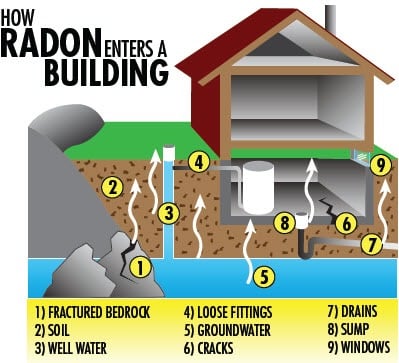Learn how to measure air quality using an indoor air quality monitor and other useful tools.
You’ve almost certainly heard us say at some point that the air inside your home can be up to five times more polluted than the air outside your home. It’s a striking statistic given how much focus is put on outdoor air pollution, and hopefully, one that will help shine some light on prevalent Indoor Air Quality (IAQ) issues that most people are not aware of.

The actual amount of air pollution in each home in the United States is going to vary, and it’s going to vary a lot. There’s a wide array of risk factors that affect IAQ and which ones are relevant can change by state, county, or even by town. If you know these risks, you can probably estimate how much indoor air pollution affects your home. If you want some piece of mind though, you can always test your indoor air. At the very least, you'll know what you're dealing with. We did the research, and here are some ways to do just that.
- Purchase an indoor air quality monitor
- Test for mold in the air.
- Install carbon monoxide alarms
- Conduct a radon test.
Purchase an indoor air quality monitor
An indoor air quality monitor is exactly what it sounds like: a device that monitors the quality of your indoor air. IAQ is not something that enough people consider, so you’re probably in the majority if you had no idea that these products existed for consumers. They do, and they are the easiest option on the market today for consistently checking your Indoor Air Quality.
What is it? An always-on electronic device that consistently tests and reports on the levels of pollution inside your home.
What does it test? This varies by device, but almost all of them test for particulate matter, chemical pollutants, and humidity. Some will track temperature, carbon monoxide, its less harmful friend carbon dioxide, and even formaldehyde levels.
Pro Tip: Particulate matter includes things like pollen and dust, and is essential to track because many IAQ issues are linked to it.
How much do they cost? While some home air quality testers retail for a little over $50, the average starting price is more like $100. The top end price is north of $300, and many sell at the middle ground of around $200. It’s not a cheap device, but it’s not too bad for a one-time investment in home wellness.
How does a home air quality tester work? Many models have a display panel that will show you values and readings in real time right on the device itself. Others opt to show overall IAQ with an indicator light and share specific readings with your phone via a dedicated app. Most are smart home enabled as well and can pair with devices like thermostats to help manage your indoor air and energy usage.
Related: What is the residents benefits package?
There are a ton of examples of good IAQ monitors you can purchase for your home. Here are just a couple.
Price: $199
Measures: Particulate matter, chemical pollutants, humiditiy, temperature
Features: Dedicated app to track readings and compare them to outside air, smarthome enabled, offers general IAQ reading with single light
Price: $99
Measures: Chemicals (VOCs), temperature, humidity, Carbon Dioxide
Features: Dedicated app to track readings, can turn on smart and non-smart devices with its external power outlet, night light
Price: $99.99
Measures: Humidity, air quality, noise, temperature
Features: Dedicated app to track readings, smarthome enabled, offers general IAQ reading with single light
Test for mold in the air.
A common household pollutant that your indoor air quality monitor won’t report on is mold. Everybody has seen mold in their home at some point, probably on some bread that they forgot to throw away. That mold is easy to deal with. You just throw away the bread. What's less obvious and a greater threat to health is airborne mold spores that are polluting your indoor air.
What type of home mold test should I use?
Home mold tests are cheap, easy to use, available at most hardware stores, and almost entirely useless. So the answer is none. You should use none of them.
A standard home mold test typically consists of a petri dish that you allow to sit in your home, along with a substance to create mold growth inside (usually something called potato dextrose). You leave the test out for a specified amount of time, and then you cap the petri dish and let it incubate for a specified amount of time. These times vary by brand, so follow the manufacturer’s guidelines. If mold grows, you have mold. If it doesn’t—well, you get the point.
Spoiler alert: there is mold in your air. Mold spores are in the air just about anywhere you could go, including inside your home. Testing for the presence of mold is like testing for the presence of air. It is there, we promise.
There are two critical questions to answer regarding mold in your home, and whether or not it is there at all is not one of them. The first is whether the amount of airborne mold spores found in your home is excessive. Since there is no official guideline from the EPA on how much mold is too much, this is usually done by comparing the concentration of mold spores floating in your home to the concentration of mold spores floating outside. It’s also a task for a professional.
You should schedule one of these tests if you believe for any reason you may have a mold issue but aren't sure since you haven't seen any. Often times, there is a musty smell that is the calling card of larger than average amounts of mold. If you find that you're coughing or sneezing more than usual, that may be a sign of high mold concentration in your home as well.
Professional mold removal service Moldman cites these eight reasons as the most common they see for mold inspections:
“8 situations that warrant testing for mold:
- You are experiencing allergic symptoms, such as stuffy head, headaches, scratchy throat, runny nose and not sure why.
- You think you see mold but are not totally sure it is mold.
- You smell a musty odor but don’t see any visible mold.
- There have been plumbing leaks or water issues in your home or office.
- You want or need air testing after mold removal has been done by you or a professional to check whether mold levels have normalized.
- You are a buyer or seller in a real estate transaction and need evidence whether airborne mold levels are not normalized.
- You a landlord or tenant and need evidence whether there is a mold problem.
- You are looking for a general assessment of your indoor air quality to make sure your family is breathing high-quality clean air in your home."
Pro Tip: If you see visible mold, you do not need to hire a professional to test your home. You’ve already identified that you have a problem the second you laid eyes on that nasty stuff. You can jump straight to hiring a professional for removal of the fungus.
If an inspection discovers that you have a mold problem in your air, the most important question becomes “what is the source of the mold?” You cannot fix the problem if you don’t know where it is coming from, and the ultimate goal is to rid your home of large amounts of mold. Your inspector should be able to conduct this investigation also.
It’s a common belief that there is a third important question, which is “what type of mold do you have?” Believe it or not, this is useless information an overwhelmingly large amount of the time. There are thousands of types of mold. Most people have heard of black mold, which is commonly believed to be “toxic mold.” The potential presence of this is the reason people often think that they should know the type of mold they are dealing with.
The truth is that most molds, including black molds, do not produce toxins, and some species are capable of toxin production only under certain conditions. Even if you have toxin-producing mold, dangers are typically associated with ingestion, not inhalation. So it is highly improbable you will inhale dangerous levels of toxins produced by mold from the air in your home. This, coupled with the fact that the removal procedure for all types of mold is pretty much identical, gives virtually no reason to care what type of mold you may have.
A professional mold inspection will be able to answer the important questions for you. For an average sized house, an inspection of your home will usually cost between $300 and $400.
Install carbon monoxide alarms.
Most Indoor Air Quality issues will have long-term and gradual effects on health. The presence of carbon monoxide (CO) is not one of those. Known as the silent killer, CO is tasteless, odorless, colorless, and it will kill you dead if you’re exposed to large amounts of it for too long.
Carbon monoxide is a byproduct of fuel combustion, so appliances like gas dryers, gas burning stoves, and gas furnaces are risk creators. If you own any of these appliances, grabbing some carbon monoxide alarms from the store is a must.
Even if you don’t own a gas dryer or stove, it can’t hurt to install these still. Carbon monoxide may not be a prominent danger in your home, but anything that burns gas creates CO. A lot of homes have gas water heaters that produce CO. And you can't forget about fireplaces. Any fire (wood burning or not) produces CO as well. In other words, just get a carbon monoxide detector. A few alarms is a small price to pay for complete assurance of safety from the silent killer.
Many indoor air quality monitors measure CO concentration and can alert you if something is afoot. That’s great, but you can’t place one in every area of your home without spending around $1000, and they don’t typically come with a screaming alarm that you can always count on to wake you up in the night. This is why you need CO alarms.
Your average carbon monoxide alarm costs about eight bucks at any local department or big-box store. There should be one within 10–15 feet of each sleeping area, and try to keep them out of corners if possible. Some are battery-powered, but many models plug directly into the wall, so the whole process can actually be as simple as opening the box, plugging it in, and boom: you’re protected.
Pro Tip: Carbon monoxide is lighter than air and rises, so logic would indicate that alarms should be placed near or on the ceiling. This would make battery-powered models a more effective option because they could be installed at any height. Contrary to this belief, studies have shown no material difference in the readings of floor level and ceiling level alarms, so an electric model plugged right into the wall will do the trick.
Conduct a radon test.
Radon, like carbon monoxide, is odorless, colorless, tasteless, and completely undetectable without a purpose-built detection device. Unlike carbon monoxide, it won’t asphyxiate you, but it is dangerous in the long-term. According to the American Cancer Society, 21,000 lung cancer deaths per year are attributed to radon exposure.
Radon can enter your home through cracks in your floors, foundation, walls, or areas around pipes. Because radon gas forms from the breakdown of natural uranium deposits in the soil, it usually enters at the lowest levels of your home and concentrates there.

Image credit: New Jersey Education Association
Short-term radon test kits can be purchased in any home improvement store or online, and National Radon Program Services at Kansas State University offers them at discounts. Unlike home mold tests, these things do provide some value by telling you how much radon is in your home.
Pro Tip: There are also electronic radon tests that continuously measure concentrations of the gas. These, like carbon monoxide alarms, are plug and play and always on. They’re not cheap though, running north of $150 for many models.
A short-term radon test is pretty easy to conduct. You simply place the test object provided in the package in the highest risk area of your home and allow it to sit for the duration of time recommended by the manufacturer, which is typically between two and seven days.
Pro Tip: As stated above, the highest risk areas of your home will be the rooms closest to the ground or below the ground. Place your test in the lowest level of your home that people will spend time in.
It’s a good idea to close windows and doors around the test area and then avoid using the area until the test is complete. This will help eliminate any external factors that can affect radon counts. After the test period is complete, you must mail the test to the manufacturer’s lab for analysis. Your short-term radon test is complete.
There are also long-term radon tests, which remain in your home from 90 days to as long as a whole year. Radon levels can fluctuate with some significance depending on the weather and time of year, so a long-term test can help determine an average over several months to a year.
The lab results will be able to inform you whether or not further action needs to be taken regarding radon in your home. If you find high levels of the gas, a professional inspection should be scheduled to identify trouble areas that can be sealed up.
Pro Tip: When buying a home, radon tests are usually conducted along with other inspections.
Like carbon monoxide, radon gas is not something to toy with. However, as long as you take some simple and easy steps and understand what you can and can’t fix on your own, you won’t be in any danger from either of these gases.
---
There are a lot of threats to Indoor Air Quality out there. Luckily, there are ways to test for all of them, sometimes cheaply, and there are fixes for all IAQ problems. Remember to keep changing your air filter, as that can help quite a bit with particulate matter and mold. And if you struggle to remember, try a Second Nature subscription (did you like that segue right there?). We’ll ship you quality air filters when it’s time to change them, so you never forget again.
Topics:




